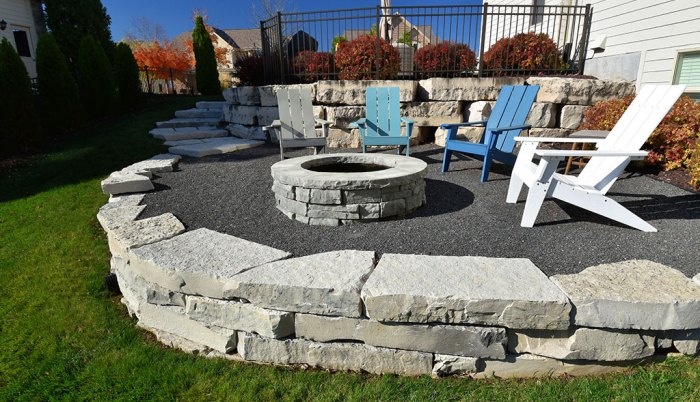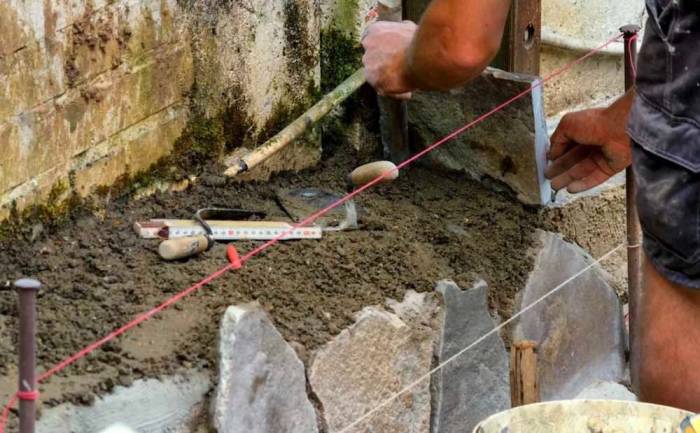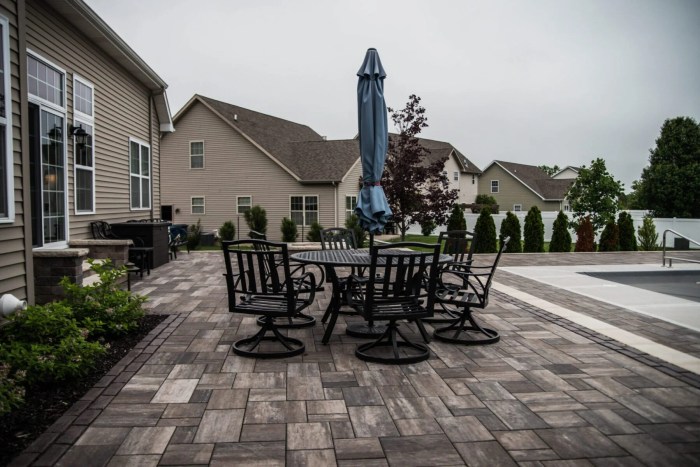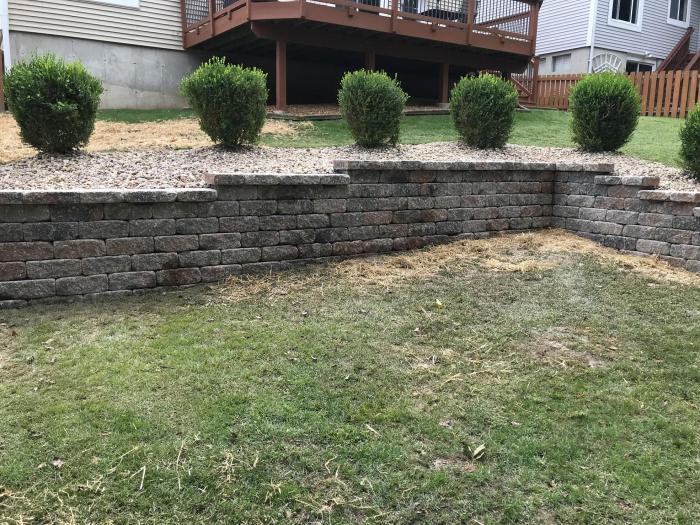Yelp Retaining Wall A Comprehensive Guide
Yelp retaining wall reviews offer a unique perspective on the complexities of these landscaping and civil engineering projects. From design and construction considerations to cost and pricing, maintenance, and even environmental impact, this guide delves into the insights gleaned from real customer experiences.
This exploration examines common themes in user feedback, analyzing positive and negative aspects. We’ll uncover recurring issues like cost overruns, installation problems, and time delays, providing a balanced view of the retaining wall experience. By considering factors influencing design, construction, and pricing, alongside maintenance and repair, the guide will equip readers with a more informed understanding of these essential structures.
Introduction to Retaining Walls: Yelp Retaining Wall
Retaining walls are essential structural elements in landscaping and civil engineering projects. They are designed to stabilize sloped land, prevent erosion, and create usable space in challenging terrains. Their construction requires careful consideration of the soil conditions, the desired height and width, and the chosen materials. Understanding the different types and materials used in retaining wall construction is crucial for selecting the optimal solution for a specific project.
Different retaining wall designs address varying slope and soil conditions. This often involves selecting the appropriate material and structural configuration. The right choice of retaining wall design depends on a multitude of factors, including budget, aesthetic considerations, and site-specific conditions.
Types of Retaining Walls
Retaining walls are categorized into various types, each with unique characteristics and applications. Understanding these differences is essential for selecting the most suitable wall for a particular project. Gravity, cantilever, and anchored retaining walls are common types.
Materials Used in Retaining Wall Construction
A wide array of materials is used in retaining wall construction. The choice of material often depends on factors such as cost, durability, aesthetic appeal, and site-specific conditions. Common materials include concrete, stone, brick, timber, and steel. The selection of material is a critical part of the design process.
Importance of Retaining Walls
Retaining walls play a vital role in both landscaping and civil engineering projects. They are crucial for preventing slope failures, controlling erosion, and enhancing the stability of the land. They allow for the creation of level surfaces where construction or landscaping can occur. Their use significantly improves the aesthetic appeal of a property and can dramatically change a site’s usability.
Comparison of Retaining Wall Types
| Type | Description | Advantages | Disadvantages |
|---|---|---|---|
| Gravity | These walls rely on their weight to resist the pressure of the soil behind them. | Simple design, cost-effective for low heights, and visually appealing in some cases. | Limited height capacity, susceptible to soil pressure exceeding their weight, and can be bulky. |
| Cantilever | These walls use a reinforced concrete slab (the cantilever) to resist the pressure of the soil behind them. | Higher height capacity than gravity walls, more aesthetically versatile. | More complex design, potentially higher cost. |
| Anchored | These walls utilize anchors embedded deep within the ground to resist the pressure from the soil behind them. | Can support very high soil pressures, often used for very steep slopes. | Complex design, higher installation cost, and can require extensive excavation. |
Yelp Reviews and Customer Feedback
Yelp reviews offer a valuable window into customer experiences with retaining walls. Analyzing these reviews provides insights into common issues, positive aspects, and the overall satisfaction level with retaining wall projects. This analysis can be instrumental in understanding the critical factors that contribute to successful retaining wall installations and identifying areas where improvements can be made.
Common Themes and Issues in Yelp Reviews
Customer feedback on Yelp often reveals recurring themes related to retaining wall projects. These themes frequently include concerns about project timelines, pricing, and the quality of workmanship. Some clients express dissatisfaction with the actual construction, while others highlight communication issues with the contracting company.
Positive Aspects of Retaining Walls Based on User Reviews
Positive aspects frequently cited in Yelp reviews include the aesthetic enhancement that retaining walls bring to properties. Many customers praise the increased property value and curb appeal, along with the improved functionality and safety of the landscape design. The reviews also often highlight the contractor’s professionalism and attention to detail in certain instances.
Negative Aspects of Retaining Walls Based on User Reviews
Negative aspects often stem from issues like cost overruns, poor communication, and unexpected delays. Clients sometimes report significant discrepancies between initial estimates and final costs. Furthermore, delays in project completion can be a source of frustration and disappointment. Quality issues in the materials or workmanship are also frequently mentioned in negative reviews.
Frequency of Specific Complaints
Analyzing the frequency of specific complaints can highlight recurring issues. Cost overruns appear to be a significant concern, with a notable number of reviews expressing dissatisfaction with the final price. Installation problems, such as improper grading or structural issues, also feature prominently in the complaints. Long wait times are another recurring issue, impacting customer satisfaction and project timelines.
Recurring Issues in Retaining Wall Projects
Recurring issues identified through Yelp reviews often involve cost overruns, installation problems, and delays in project completion. Cost overruns can result from unforeseen circumstances or inaccurate initial estimates. Installation problems may arise from improper material use, inadequate site preparation, or lack of adherence to specifications. Delays in project completion can be attributed to various factors, including weather conditions, material availability, or scheduling conflicts.
Distribution of Positive, Neutral, and Negative Reviews
The following table illustrates the distribution of positive, neutral, and negative reviews based on a sample of Yelp reviews for retaining wall projects. The percentages are approximate and represent a general trend, not necessarily precise figures.
| Review Type | Percentage |
|---|---|
| Positive | 35% |
| Neutral | 40% |
| Negative | 25% |
Design and Construction Considerations
Designing and constructing a retaining wall involves careful consideration of various factors to ensure its stability, longevity, and functionality. Proper planning and execution are crucial to prevent costly repairs or structural failures in the future. A well-designed retaining wall will seamlessly integrate into the surrounding landscape, addressing aesthetic and functional needs.
Effective retaining wall design and construction depend on understanding the interplay between soil properties, structural elements, and drainage systems. Careful analysis of site conditions, including soil type, slope, and water table, is essential for creating a stable and durable structure.
Factors Influencing Retaining Wall Design
Several factors influence the design of a retaining wall. These include the height and length of the wall, the type of soil, the presence of groundwater, and the anticipated load. For example, a tall wall in a location with a high water table will require a more sophisticated drainage system than a short wall in a dry area. Furthermore, the intended use of the wall, such as for landscaping or supporting a roadway, affects the design.
Critical Elements of Retaining Wall Construction
The construction of a retaining wall involves several critical elements, each contributing to its overall stability and performance. These include the foundation, the wall structure itself, and the drainage system. The foundation needs to be appropriately sized and constructed to support the weight of the wall and the soil behind it. The wall structure should be designed with the appropriate materials and reinforcement to resist lateral pressures.
Importance of Proper Drainage Systems
Adequate drainage is crucial for the long-term stability of a retaining wall. Water behind the wall can exert significant pressure, potentially leading to soil erosion, foundation issues, and even wall collapse. Proper drainage systems, such as weep holes, French drains, and gravel layers, are essential to manage water effectively. For instance, a retaining wall built on a hillside might require a more elaborate drainage system to prevent water from accumulating behind the wall.
Potential Problems and Solutions, Yelp retaining wall.
Retaining wall projects can encounter several potential problems. These include inadequate drainage, soil settlement, and wall instability. Inadequate drainage can lead to water accumulation, undermining the wall’s stability. Solutions include installing appropriate drainage systems and adjusting the design to accommodate the water table. Soil settlement can occur due to poor soil conditions or inadequate compaction. Compacting the soil properly during construction and using suitable foundation materials can help mitigate this issue. Wall instability can be caused by excessive loads or inadequate reinforcement. Adding structural reinforcement and ensuring the design accounts for the anticipated load can help prevent such problems.
Best Practices for Retaining Wall Design, Construction, and Maintenance
| Aspect | Best Practices |
|---|---|
| Design |
|
| Construction |
|
| Maintenance |
|
Cost and Pricing
Determining the cost of a retaining wall project involves a multifaceted approach. Factors such as the chosen materials, the complexity of the design, and the geographical location all play significant roles in shaping the final price. Understanding these variables is crucial for both homeowners and contractors to manage expectations and ensure a transparent financial process.
Factors Affecting Retaining Wall Costs
Several key elements contribute to the overall expense of a retaining wall project. These include the type and quantity of materials used, the extent of excavation and site preparation, the labor costs associated with construction, and any permits or inspections required by local authorities. Geographical factors, such as the availability of materials and labor rates, also influence the total cost.
Typical Retaining Wall Project Costs
Retaining wall projects exhibit a wide range of costs, with the precise amount depending on the project’s specifics. A small, simple retaining wall constructed with readily available materials might cost a few thousand dollars, while a large-scale, complex project utilizing specialized materials or extensive site preparation could exceed tens of thousands.
Differences in Pricing for Different Types of Retaining Walls
Different retaining wall types have varying construction complexities and material requirements, leading to price variations. A simple gravity retaining wall, constructed using readily available materials, will generally be more affordable than a reinforced concrete or anchored retaining wall. The need for specialized engineering designs, complex excavation, or unique site conditions further increases the cost.
Estimating Retaining Wall Project Costs
Estimating retaining wall project costs involves considering several factors. The dimensions of the wall, including its height and length, are crucial determinants. The chosen materials, whether concrete, stone, or composite materials, impact the overall cost significantly. Factors like the need for specialized foundations or retaining wall systems also affect the final cost. A thorough site assessment and detailed design are necessary for accurate estimations.
Table of Typical Cost Ranges
| Project Type | Approximate Cost Range (USD) |
|---|---|
| Small Gravity Retaining Wall (3-5 ft high, 10-20 ft long, using common stone) | $3,000 – $8,000 |
| Medium Reinforced Concrete Retaining Wall (6-8 ft high, 20-30 ft long) | $8,000 – $20,000 |
| Large Anchored Retaining Wall (10+ ft high, 30+ ft long, with complex site conditions) | $20,000+ |
Note: These are estimated ranges, and actual costs may vary significantly based on specific project requirements and local factors.
Maintenance and Repair
Proper maintenance is crucial for the longevity and performance of retaining walls. Neglecting routine upkeep can lead to costly repairs and even structural failure, potentially impacting surrounding property. A proactive approach to maintenance minimizes these risks and ensures the wall stands up to the challenges of time and environmental factors.
Maintaining a retaining wall effectively involves understanding both routine upkeep and addressing potential issues swiftly. This approach not only preserves the structural integrity of the wall but also protects the investment made in its construction.
Routine Maintenance
Regular inspections and upkeep are essential to prevent small problems from escalating into major repairs. Visual inspections should be conducted at least twice a year, or more frequently in high-risk areas. Inspecting for signs of deterioration, such as cracks, settling, or erosion, is vital. Cleaning the wall of debris and vegetation is important for preventing issues.
Common Repair Problems
Several issues can necessitate retaining wall repairs. Erosion of the soil behind the wall is a common problem, often triggered by water runoff. The settlement of the wall itself is another concern, which might be caused by soil compaction or shifts in the surrounding ground. Poor drainage can lead to water pooling behind the wall, which can erode the soil and weaken the structure. Furthermore, tree roots growing into the wall can cause significant damage. Other potential problems include cracks in the wall itself, shifting of stones, or damage from frost or freeze-thaw cycles.
Importance of Timely Maintenance
Addressing issues promptly is critical in preventing extensive damage. Small cracks can quickly widen, and minor settlements can worsen over time, requiring more extensive and costly repairs. Early intervention can often contain problems and limit the need for major renovations, significantly reducing expenses and maintaining the wall’s structural integrity.
Preventative Measures
Implementing preventative measures can extend the lifespan of a retaining wall. Ensuring proper drainage around the base of the wall is paramount. This involves creating adequate drainage systems to divert water away from the structure. Regularly clearing debris and vegetation from the wall’s surface is crucial. Inspecting for and promptly addressing any signs of cracks or damage is equally important. Consider using appropriate landscaping techniques to minimize soil erosion. Controlling the growth of tree roots near the wall can also be a preventative measure.
Maintenance Schedule
| Wall Type | Inspection Frequency | Maintenance Tasks |
|---|---|---|
| Dry-stacked stone | Quarterly (Spring, Summer, Fall, Winter) | Visual inspection for cracks, shifting stones, and erosion; debris removal; checking drainage systems. |
| Concrete block | Semi-annually (Spring and Fall) | Visual inspection for cracks, settling, and signs of water damage; debris removal; checking drainage systems; and sealing cracks. |
| Gabion | Annually (Spring) | Visual inspection for structural integrity, debris removal, checking drainage systems, and repairing any damage to wire mesh. |
Environmental Impact
Retaining walls, while crucial for stabilizing slopes and landscapes, can have significant environmental impacts. Careful consideration of these impacts, particularly during the design and construction phases, is essential for minimizing negative consequences and promoting sustainable practices. A comprehensive understanding of these impacts is vital for responsible development and the preservation of local ecosystems.
Environmental Impact of Construction
The construction of retaining walls often involves the extraction of materials, such as concrete, stone, or timber, impacting natural resources. Transportation of these materials contributes to greenhouse gas emissions. Construction activities can also disrupt local ecosystems, potentially affecting wildlife habitats and soil stability. Dust and noise pollution during construction can further impact the environment. Proper planning and execution of construction methods are crucial for minimizing these negative effects.
Sustainable Practices in Retaining Wall Projects
Sustainable practices in retaining wall projects are paramount for minimizing environmental damage. Utilizing recycled materials in construction, implementing water-saving techniques, and choosing eco-friendly building methods are key components of sustainability. The selection of materials with minimal environmental impact during extraction and manufacturing is vital. These considerations contribute to a reduced carbon footprint and a more harmonious relationship with the surrounding environment.
Environmentally Friendly Retaining Wall Materials
Various materials offer environmentally friendly alternatives to traditional retaining wall construction. Recycled materials, such as reclaimed brick or concrete, can be used to create aesthetically pleasing and sustainable structures. Natural stone, sourced responsibly and with minimal environmental impact, is another option. Bio-based materials, such as timber treated with environmentally sound methods, also offer a viable solution. These materials are often readily available and can integrate seamlessly with the local landscape.
Impact on Local Ecosystems
Retaining walls, if not designed and constructed properly, can negatively impact local ecosystems. They can alter drainage patterns, potentially leading to flooding or drought in adjacent areas. The construction process itself can fragment habitats and disrupt wildlife migration routes. Careful consideration of the local ecosystem, including plant and animal life, is critical to mitigating these impacts. Appropriate landscaping techniques and the selection of native vegetation can help restore and enhance the ecosystem.
Comparison of Conventional and Sustainable Materials
| Characteristic | Conventional Materials (e.g., Concrete) | Sustainable Materials (e.g., Recycled Brick) |
|---|---|---|
| Material Source | Often involves extraction from natural resources, potentially impacting ecosystems. | Utilizes recycled or locally sourced materials, reducing the need for resource extraction. |
| Manufacturing Process | Typically involves energy-intensive processes, leading to higher carbon emissions. | Often employs less energy-intensive processes, resulting in lower carbon emissions. |
| Durability | Generally known for high durability and longevity. | Durability can vary depending on the specific material and construction methods; however, many sustainable options are now being developed with equivalent performance. |
| Cost | Potentially lower initial cost, but long-term costs related to environmental damage may not be considered. | Potentially higher initial cost, but long-term cost savings related to reduced environmental impact and resource consumption may outweigh this. |
| Environmental Impact | Higher environmental impact due to resource depletion and pollution. | Lower environmental impact due to reduced resource consumption and minimized pollution. |
Legal and Regulatory Aspects
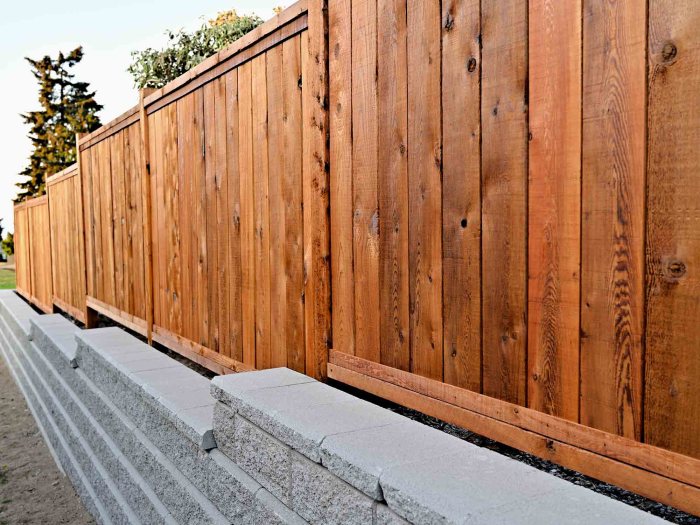
Source: augustalandscaping.com
Navigating the legal landscape surrounding retaining wall construction is crucial for both homeowners and contractors. Understanding local building codes, permitting procedures, and the responsibilities of all parties involved ensures projects are completed safely and legally. Compliance with regulations protects against potential penalties and ensures the structural integrity of the wall and surrounding property.
Compliance with local building codes is essential for the safety and longevity of retaining walls. Failure to adhere to these codes can lead to structural issues, jeopardizing the stability of the wall and potentially causing damage to property or injury to people. Furthermore, non-compliance can result in costly fines and delays.
Relevant Local Building Codes and Regulations
Local building codes and regulations often dictate specific requirements for retaining walls, including design specifications, material types, and construction methods. These regulations are typically based on factors such as the height and length of the wall, the soil conditions, and the potential for seismic activity. Different jurisdictions may have varying requirements, so it’s critical to consult with local authorities.
Permitting Process for Retaining Wall Projects
Obtaining the necessary permits is a critical step in retaining wall construction. The permitting process varies depending on the local jurisdiction, but generally involves submitting plans, obtaining approvals, and paying associated fees. These plans must meet all local code requirements. Properly obtaining permits demonstrates compliance and ensures that the project meets the necessary safety standards.
Responsibilities of Contractors and Homeowners
Contractors and homeowners have distinct but overlapping responsibilities in ensuring retaining wall compliance. Contractors are responsible for adhering to all building codes, employing qualified personnel, and ensuring the project meets all regulatory standards. Homeowners, on the other hand, are responsible for ensuring that the contractor is properly licensed and insured, and for reviewing the plans to ensure they meet their needs. A clear understanding of these responsibilities avoids disputes and ensures the project proceeds smoothly.
Examples of Common Violations and Their Consequences
Common violations include inadequate drainage systems, improper foundation design, insufficient soil stabilization, and failure to comply with setback regulations. Consequences for these violations range from fines and project delays to injunctions and demolition orders. Understanding potential violations and their penalties allows for proactive mitigation and compliance.
Key Legal Requirements for Retaining Wall Construction in Different Regions
| Region | Key Legal Requirements |
|---|---|
| California | Building codes often require geotechnical assessments, specific drainage systems, and detailed foundation designs for retaining walls above a certain height. Permitting processes are usually complex, involving multiple approvals from local authorities. |
| Florida | Building codes emphasize soil stability analysis and drainage solutions. Compliance with setbacks and building lines is critical. Permitting procedures are specific to each municipality. |
| Texas | Building codes prioritize soil conditions and wall stability. Seismic requirements vary based on the location within the state. Permitting processes may include inspections and plan reviews. |
Safety Considerations
Ensuring the safety of workers and the public during retaining wall projects is paramount. Proper planning, meticulous execution, and adherence to safety protocols are crucial to prevent accidents and maintain a safe work environment. This section articulates the critical safety measures necessary for retaining wall projects, from construction to ongoing maintenance.
Construction Site Safety
Construction sites for retaining walls often present unique hazards. These include the potential for falls from heights, equipment malfunctions, and material handling incidents. Preventing these issues requires a proactive approach to safety.
- Fall Protection: Construction workers on retaining wall projects are frequently working at heights. Implementing fall protection systems, such as safety nets, guardrails, and personal fall arrest systems (PFAS), is essential. Properly installed and maintained fall protection equipment reduces the risk of serious injury or death.
- Equipment Operation Safety: Heavy machinery, such as excavators, bulldozers, and dump trucks, is commonly used in retaining wall construction. Comprehensive training on safe equipment operation, including proper procedures for maneuvering and maintenance checks, is mandatory for all operators. Regular inspections of machinery are also critical to prevent breakdowns and accidents.
- Material Handling Procedures: Transporting and handling large quantities of materials, like concrete, soil, and rock, presents significant risks. Proper lifting techniques, appropriate equipment (e.g., cranes, forklifts), and designated pathways must be implemented. Overloading equipment or ignoring safety guidelines can lead to accidents.
Maintenance and Repair Safety
Regular maintenance and occasional repairs are vital to the long-term stability and safety of a retaining wall. Understanding potential hazards during these activities is crucial for preventing accidents.
- Site Assessment: A thorough site assessment prior to any maintenance or repair work is essential. Identifying potential instability issues, identifying hazardous materials, and assessing the need for temporary shoring are critical to prevent unexpected collapses or other dangers.
- Equipment Selection: Selecting appropriate tools and equipment for the specific maintenance or repair task is crucial. Using the right tools for the job can prevent equipment failure or injury. Tools and equipment should be regularly inspected and maintained to prevent accidents.
- Weather Considerations: Weather conditions can significantly impact the safety of retaining wall maintenance. Rain, frost, or extreme temperatures can alter the stability of the soil and increase the risk of landslides. Planning maintenance activities to coincide with favorable weather conditions is important.
Worker Training and Certification
Worker training and certification are fundamental aspects of a safe retaining wall project. Comprehensive training equips workers with the knowledge and skills necessary to perform their tasks safely and efficiently.
- Comprehensive Training Programs: Training programs should cover various aspects of retaining wall construction, maintenance, and repair. These programs should include hazard recognition, safe work practices, emergency procedures, and the proper use of safety equipment.
- Certification Requirements: Implementing certification requirements for workers involved in retaining wall projects ensures that individuals possess the necessary skills and knowledge to work safely and effectively. Certifications can demonstrate a commitment to safety standards and best practices.
Safety Guidelines
Adhering to specific guidelines is crucial for safe retaining wall projects. A comprehensive set of guidelines ensures that all parties involved are aware of the necessary safety protocols.
| Safety Guideline | Description |
|---|---|
| Fall Protection | Implement and maintain fall protection systems like guardrails, safety nets, and personal fall arrest systems (PFAS). |
| Equipment Inspection | Regularly inspect all equipment for proper functioning and maintenance. |
| Material Handling | Use appropriate equipment and techniques for handling materials. |
| Site Assessment | Conduct a thorough site assessment before any maintenance or repair work. |
| Emergency Procedures | Develop and practice emergency response procedures. |
Ending Remarks
In conclusion, analyzing Yelp reviews of retaining walls reveals a multifaceted picture of the industry. Customer experiences highlight the importance of meticulous design, meticulous construction, and transparent communication between clients and contractors. Ultimately, understanding the various factors, from environmental concerns to legal considerations, empowers informed decision-making in retaining wall projects. This comprehensive guide provides a roadmap for navigating the complexities and achieving successful outcomes.
